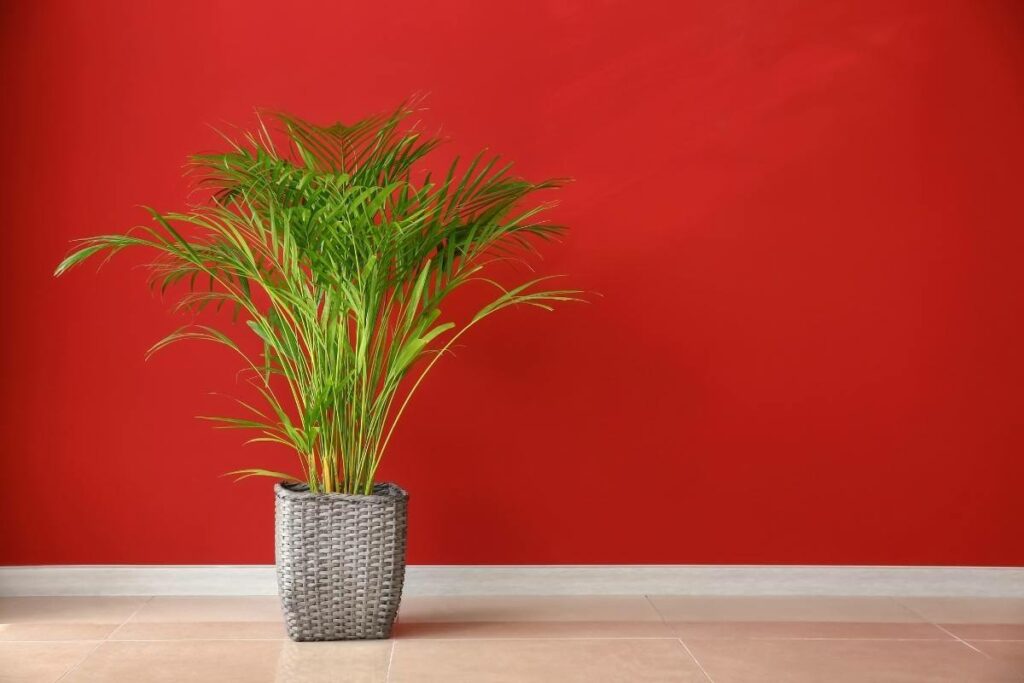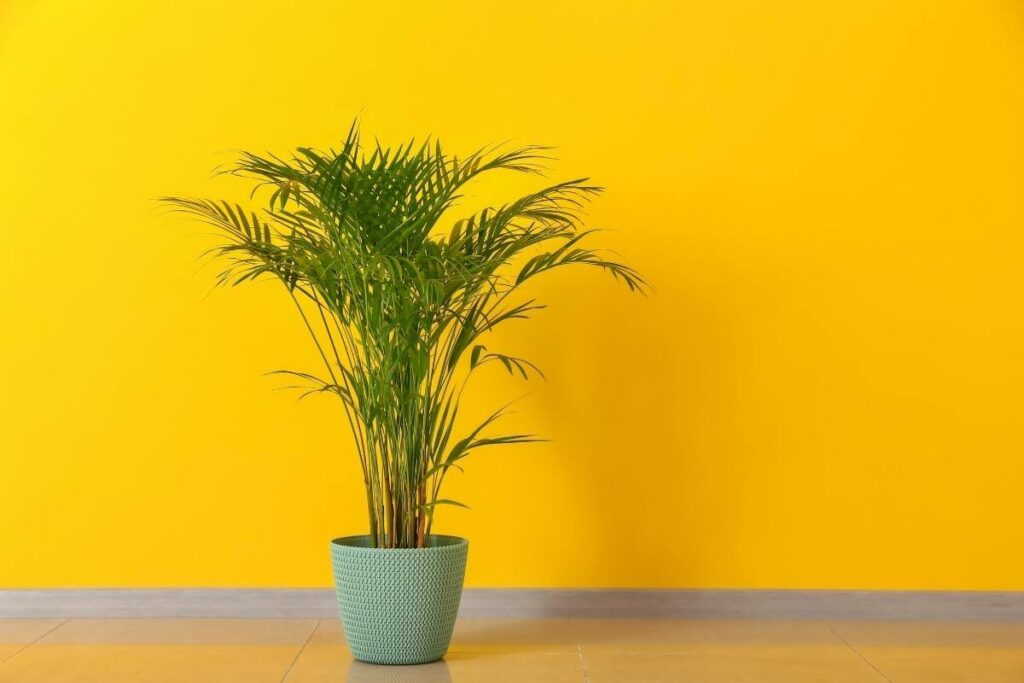Areca palm is an aesthetic plant mainly used indoors to complement any decor.
Although it is simple to care for, it takes a lot of effort to keep its lovely appearance.
Some of the symptoms of a dying Areca plant include drooping and yellow fronds, brown tips, and leaf falls.
Drooping is harmful in Areca palm because it can cause wilt, which can destroy the plant.
It is caused mainly by inappropriate watering frequency and volume, whether overwatering or underwatering, insufficient air humidity, and the presence of pests on the plant that suck up Areca palm fluids.
The good news is that drooping on an Areca palm may often be reversed. For the palm tree to recover, you should create an ideal environment with the proper humidity level, well-draining soil, maintain an appropriate watering routine, and be pest-free.
What Causes a Droopy Areca Palm?
There are several causes for Areca palm drooping.
Droopy leaves that hang limply from the stem signal that the plant is in danger and that you are not supplying the appropriate quantity of water or humidity.
Overwatering, underwatering, and air humidity are all common causes of drooping.
| Causes Of A Droopy Areca Palm | How To Address Causes Of A Droopy Areca Palm? |
|---|---|
| Overwatering and underwatering. | Change your watering schedule and try to keep the soil wet but not waterlogged. Repot using a well-draining potting mix and a pot with drainage holes. |
| Low humidity level. | You may place the plant in a tray half-filled with gravel and half-full water; spray/mist the leaves at least once a day or place a humidifier near the plant. |
| Pest infestations. | Get rid of pests by misting the leaves. Rub or rinse the palm tree with alcohol, neem oil, insecticidal soaps, warm soapy water, and a pyrethrin-based repellant or a professional insect remover. |
Overwatering and Underwatering Droopy Areca Palm
Incorrect watering is the most prevalent cause of drooping leaves. Drooping leaves are frequently one of the first indications of a plant suffering from either dry soil or too much water.
When there isn’t enough moisture in the soil of the Areca Palm, it might result in limp leaves.
Like other plants, the Areca Palm loses water via its leaves through transpiration which it requires replenishing by sucking water through its roots.

Sadly, underwatered soil lacks enough water making the roots unable to restore the lost moisture content resulting in a drooping plant.
Furthermore, too much water can cause the same drooping. When there is too much water or just heavy soil that does not drain correctly, the roots become suffocated and cannot suck in water and nutrients effectively.
Too much water in the soil drowns out any air pockets from which the roots might collect oxygen. When this happens, the roots lose their ability to absorb moisture and nutrients.
Take Action: Suppose you overwatered your palm tree, attempt to save it as quickly as possible. Leaving it in damp soil might induce fungal root rot, killing the plant and making reviving it impossible.
Humidity
The optimal humidity range for Areca palm plants to grow indoors is 40% to 50%.
When the humidity goes below or above the ideal range, Areca palm leaves may droop, and the leaves’ tips may turn brown.
Pest Infestations of Areca Palm
If the water and humidity issue does not appear to be the source of the problem, inspect the plants to see any evidence of insects.
Pest infestations can also cause droopy leaves. When too many pests consume your plant’s fluids, it causes the same loss of internal water pressure as too-dry soil.
The most common indoor plant pests that can cause drooping are sap-sucking insects such as aphids, scale, mealybugs, and spider mites.
Pest infestations may swiftly eat away at the plant’s leaves, causing it to droop and eventually perish.
Can a Drooping Areca Palm Come Back To Life? (How To Save Drooped Areca Palm?)

If properly cared for, Areca palms can be spared from additional drooping, withering, or death:
- The first step is to identify the circumstances that have caused it to droop. There might be a problem with humidity or the frequency of watering.
- Then verify that the plant’s soil is healthy and ideal to mend itself.
Maintaining Humidity
A high humidity level is required to keep an Areca palm looking healthy.
A hygrometer may be purchased to assist you in measuring the humidity of the plant’s surroundings.
If humidity is an issue, place the plant in a tray half-filled with gravel and half-full water.
You may also spray the leaves at least once a day to keep your Areca plant’s humidity at an ideal level. You may increase humidity even more by placing a humidifier near the plant.
If humidity is an issue, place the plant in a tray half-filled with gravel and half-full water. You may also spray the leaves at least once a day to keep your Areca plant’s humidity at an ideal level.
Works Well: You may increase humidity even more by placing a humidifier near the plant.
Watering Correctly
The watering routine causes drooping Areca palm.
Before each watering session, inspect the soil and the amount of water you pour into it. The best method to maintain a healthy palm is to keep an eye on its water requirements.
Water them frequently enough in the spring and summer to keep the soil gently damp.
During fall and winter, try to keep the soil somewhat dry because the plant is usually in a semi-dormant state.
However, if you allow the soil to dry up completely, the Areca Palm will droop and wilt. It is a thirsty plant that you must water regularly.
Yet, underwatering might cause its fronds to droop; on the positive side, once saturated, the plant will stand up again.
What If the Leaves Fall Off
If you observe the palm’s leaves starting to droop, it’s essential to change your watering schedule at once to avoid additional harm to the plant.
Try to keep the soil of your Areca Palm wet at all times but not waterlogged. Put a water tray at the bottom of your plant container to help with drainage.
Even though Areca Palm requires frequent watering, you may overwater the plant. The golden palm is susceptible to overwatering, and its leaves will begin to droop as a result.
If you do not address the problem, leaves will ultimately fall off.
A poorly draining potting mix can also cause waterlogged conditions. Check that the pot has drainage holes and that the potting mix drains effectively.
If that is not the case, repot the plant in a new container filled with fresh potting soil.
Checking the Roots
Inspect the roots for rot if you suspect over-watering as the reason for drooping.
Mushy roots and a foul odor are symptoms of root rot. Healthy roots, on the other hand, will be firm and white.

You can use horticultural hydrogen peroxide to cure root rot. It provides full quantities of oxygen to the roots.
After a thorough watering or heavy rain, you should repot palms into fresh soil of a good mix and an appropriately-sized pot with enough drainage holes.
Adding peat moss or perlite to the topsoil of your plants can also assist with drainage:
- Remove the plant from the pot, then thoroughly remove the dirt from the roots and cut off any severely damaged roots.
- Then soak the roots for an hour in a solution of 1-quart water (at 660F) to 1 oz—hydrogen peroxide.
- Alternatively, add 2 1/2 tablespoons of 3% hydrogen peroxide to a gallon of water and only use this solution to water the plant until it revives.
Mitigating Pests
If you detect any webbing on the plants or speckled patches on the leaves, you have a spider mite infestation.
You may be able to get rid of these pests by simply spraying the leaves with water, as dusty conditions might attract these bugs.
Try rubbing alcohol, neem oil, insecticidal soaps, or rinsing the plants in warm soapy water with a pyrethrin-based repellant if the misting fails.
You can repeat this process every two to three days if necessary per week since some pests might be tough to eradicate.
Be Creative: If it doesn’t work, go to your local plant or hardware store and try a professional insect remover.
Final Thoughts
The key to reviving a drooping or dying Areca is to determine the source of the problem.
Overwatering, underwatering, and air humidity are all common causes. If an Areca palm is not revived in time, it will die from drooping.
The sooner you address the issue, the better your chances of saving the palm plant and keeping it from getting droopy in the future.
